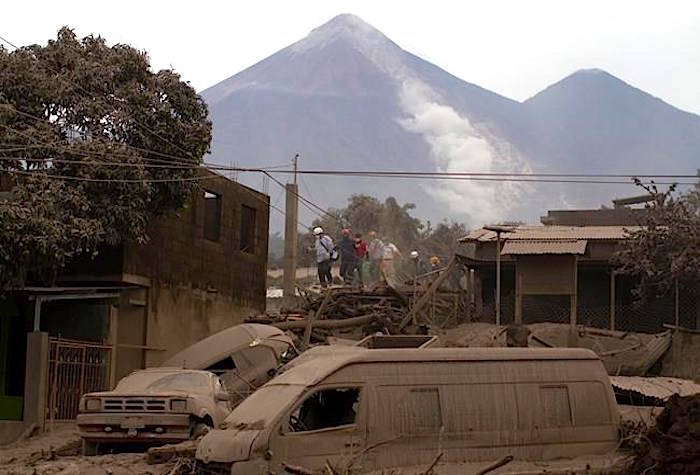Rescuers on Monday pulled at least 10 people alive from ash drifts and mud flows that poured down the slopes of Guatemala’s erupting Volcano of Fire, but officials said at least 33 people were dead and the toll was expected to rise.
The head of the country’s disaster agency, Sergio Cabanas, gave the updated death toll, but said rescuers using helicopters had pulled 10 people from areas swept over by a towering cloud of thick ash, mud or lava.
Residents of El Rodeo, about 8 miles (12 kilometres) downslope from the crater, said they were caught unaware by fast-moving pyroclastic flows when the volcano west of Guatemala City exploded Sunday, sending towering clouds of ash miles into the air.
Searing flows of ash mixed with water and debris down its flanks, blocking roads and burning homes.
The charred landscape left behind was still too hot to touch or even to pull bodies from in many parts, melting the shoes of rescuers. Workers told of finding bodies so thickly coated with ash they appeared to be statues. Inhaling ash or hot volcanic gases can asphyxiate people quickly.
Hilda Lopez said the volcanic mud swept into her village of San Miguel Los Lotes, just below the mountain’s flanks. She still doesn’t know where her mother or her sister are.
“We were at a party, celebrating the birth of a baby, when one of the neighbours shouted at us to come out and see the lava that was coming,” Lopez recalled. “We didn’t believe it, and when we went out the hot mud was already coming down the street.”
“My mother was stuck there, she couldn’t get out,” said Lopez, weeping and holding her face in her hands.
Disaster agency spokesman David de Leon said 18 bodies had been found in San Miguel Los Lotes. Lopez’s husband, Joel Gonzalez, said his father was had been unable to escape and was believed to be “buried back there, at the house.”
In the village of El Rodeo, heavily armed soldiers wearing blue masks to ward off the dust stood guard behind yellow tape cordoning off the scene as orange-helmeted workers operated a backhoe. A group of residents arrived at the scene with shovels and work boots.
Some locals said they never learned of the danger until it was upon them — and were critical of authorities.
“Conred (the disaster agency) never told us to leave. When the lava was already here they passed by in their pickup trucks telling at us to leave, but the cars did not stop to pick up the people,” said Rafael Letran, a resident of El Rodeo. “The government is good at stealing, but when it comes to helping people they lack spark.”
Eddy Sanchez, director of the country’s seismology and volcanology institute, said the flows reached temperatures of about 1,300 degrees Fahrenheit (700 Celsius).
At least 20 people were injured, and authorities have said they feared the death toll could rise with an undetermined number of people unaccounted for. The disaster agency said 3,265 people had been evacuated.
Dramatic video showed a fast-moving lahar, or flow of pyroclastic material and slurry, slamming into and partly destroying a bridge on a highway between Sacatepequez and Escuintla.
Among the fatalities were four people, including a disaster agency official, killed when lava set a house on fire in El Rodeo, National Disaster Coordinator Sergio Cabanas said. Two children were burned to death as they watched the volcano’s second eruption this year from a bridge, he added.
Ash from the volcano, which lies about 27 miles (44 kilometres) west of Guatemala City, fell on the capital area as well as the departments of Sacatepequez, Chimaltenango and Escuintla. Streets and houses were covered in the colonial town of Antigua, a popular tourist destination.
Aviation authorities closed Guatemala City’s international airport because of the danger posed to planes, but the airport was reopened at mid-morning Monday after workers cleared away ash.
One of Central America’s most active volcanos, the conical Volcan de Fuego reaches an altitude of 12,346 feet (3,763 metres) above sea level at its peak.
The Associated Press



